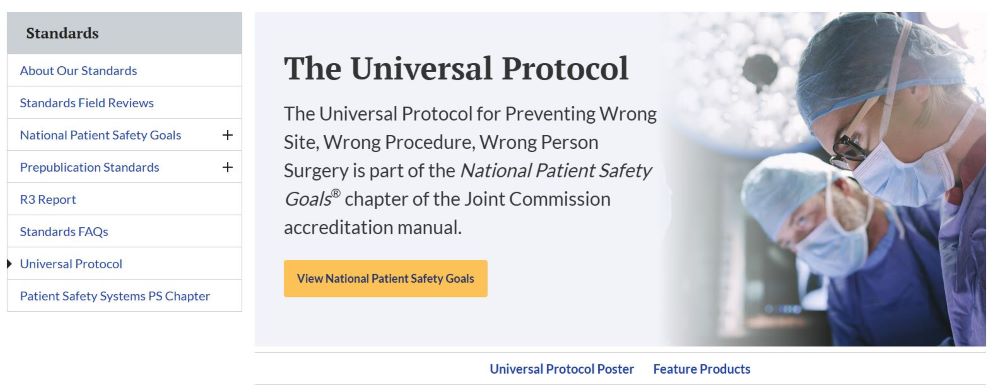Last Updated on November 7, 2024 by Michelle Wan
Wrong site surgery is one of the most alarming forms of medical errors. These preventable mistakes, where a procedure is performed on the wrong side, wrong site, or even the wrong patient, can have devastating consequences. This article is a comprehensive guide to understanding how wrong surgeries happen and how they can be prevented, emphasizing the importance of patient safety.
We’ll explore the role of the Universal Protocol, developed by the Joint Commission, and offer actionable insights to ensure that both healthcare professionals and patients are safeguarded from such preventable medical errors. This article is crucial for anyone seeking to understand the causes, consequences, and prevention of wrong surgeries in modern healthcare settings.
How Common Is Wrong Site Surgery
Wrong surgery is a preventable medical error where a procedure is performed on the wrong part of the body, the wrong side, or even on the wrong person. Despite advancements in surgical safety protocols, the incidence of wrong-site surgery still occurs more frequently than most would expect.
According to reports, it is classified as a sentinel event, meaning it is an unexpected event that causes serious harm to the patient and is often preventable. Wrong surgery can lead to serious adverse events that may affect a patient’s quality of life, cause emotional distress, or lead to medical malpractice claims.
The most common types of wrong site surgeries include orthopaedic procedures, spinal surgeries, and wrong-patient operations.
How Does the Universal Protocol Prevent Wrong Site Surgery
The Universal Protocol was developed by the Joint Commission on Accredition to prevent wrong site surgeries by standardizing procedures and ensuring that all health care professionals follow stringent steps before operating. This protocol includes site marking, time-outs, and proper documentation to ensure the correct site and correct procedure are performed.

By adhering to the Universal Protocol, medical teams can significantly reduce the risk of wrong surgery. It is a key tool in maintaining patient safety and quality in surgical care, and its implementation has become a global standard in many hospitals or in any medical center.
Why Do Wrong Site Surgeries Occur
There are several reasons why wrong site surgeries happen, despite the measures in place to prevent them. Some of the most common root causes include:
- Poor communication among the surgical team.
- Failure to properly mark the surgical site before the procedure.
- Inadequate patient identification processes.
- Mislabeling of patient records or medical charts.
- Human errors, such as fatigue or rushing during pre-surgical checks.
Understanding these causes can help healthcare professionals focus on improving systems and practices to reduce the chances of the wrong person surgery or the wrong person.
Steps in the Universal Protocol
The Universal Protocol for preventing wrong surgery consists of three critical steps:
- Pre-operative Verification Process: This ensures that all patient documents, including consents and medical records, are in order and confirm the correct patient and procedure.
- Marking the Operative Site: The surgical site is clearly marked with the patient’s involvement to prevent surgery on the wrong part of the body.
- Time-Out: Just before the surgery, the entire surgical team takes a moment to confirm the patient’s identity, the procedure being performed, and the correct surgical site.
Each of these steps is crucial in preventing wrong surgery and ensuring safe patient care.
Patients Contribute to Preventing Wrong Site Surgery

Patients can help by:
- Asking questions about the procedure to fully understand what will happen.
- Ensuring that their surgical site is correctly marked before the operation.
- Confirming their identity and the procedure with the medical team.
By encouraging patient involvement, healthcare providers can enhance patient safety and reduce the likelihood of adverse events.
Role of Site Marking in Preventing Wrong Site Surgery
Site marking is a critical part of the Universal Protocol. The surgical team must mark the correct site on the patient’s body to ensure that the operation is performed on the right side and in the right location. Marking the operative site is particularly important in surgeries where there may be confusion, such as bilateral surgeries or cases involving multiple procedures.
Incorrect or absent site marking has been a frequent root cause of wrong surgeries. Therefore, healthcare professionals must be diligent in following this step to prevent surgery on the wrong side.
Time-Outs and How Do They Prevent Wrong-Site Surgery
A time-out is a crucial step in the Universal Protocol for preventing wrong surgery. Before the surgery begins, the entire surgical team pauses to confirm:
- The patient’s identity.
- The procedure being performed.
- The operative site.
This pause helps to ensure that all the surgical team members are on the same page and that there is no confusion regarding the surgical patient or the procedure. Time-outs are an effective way to prevent errors and enhance overall surgical safety.
How Are Wrong Site Surgeries Reported
When surgery occurs, it must be reported as a sentinel event to the Joint Commission or other regulatory bodies and implement changes that can prevent future occurrences.

The reporting of sentinel events plays a significant role in improving patient safety across healthcare facilities. By analyzing the causes of wrong site surgeries, hospitals can develop better protocols and training to prevent such events in the future.
Impact of Wrong Surgery on Patient Outcomes
The impact of wrong surgery on patient outcomes can be devastating. In many cases, it leads to long-term disability, emotional trauma, or even death. Patients who undergo surgery on the wrong side, the wrong body part, or the wrong procedure may require additional surgeries to correct the error, prolonging recovery time and increasing the risk of complications.
These outcomes often result in medical malpractice claims, where the patient seeks compensation for the harm caused by the wrong surgery. Ensuring correct site surgery is performed is vital to avoiding these life-altering consequences.
Effective Strategies for Preventing Wrong Surgery
There are several strategies that healthcare providers can implement to further reduce the incidence of wrong surgery. These include:
- Ensuring that all surgical staff are trained in the Universal Protocol.
- Using surgical safety checklists to verify key details before and during the procedure.
- Encouraging open communication between surgical team members to prevent misunderstandings.
- Conducting routine audits of wrong surgery cases to identify trends and areas for improvement.
By focusing on these strategies, healthcare providers can work towards the goal of eliminating wrong surgeries and improving overall patient safety.
In summary, wrong surgery is a significant yet preventable medical error. The implementation of the Universal Protocol and other safety measures has greatly reduced the occurrence of such errors, but ongoing vigilance is needed to protect patients from harm.
By adhering to safety protocols, engaging patients in their care, and fostering a culture of communication within surgical teams, healthcare providers can continue to improve surgical safety and ensure better outcomes for their patients.
By focusing on these areas, both healthcare professionals and patients can work together to ensure that surgeries are performed safely and correctly, reducing the likelihood of devastating errors.




